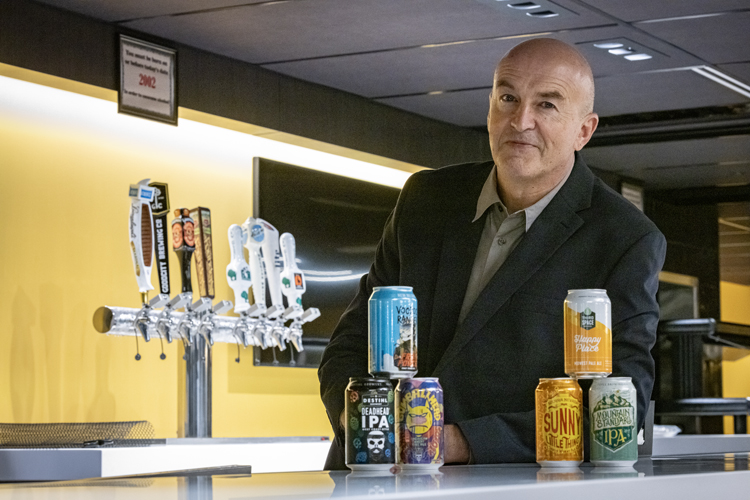
Stanislav Dobrev, professor of organizations and strategic management in the UWM Lubar College of Business, shows some examples of craft beer names. Positive names include Sunny Little Thing and Happy Place. More negative or quirky names are Voodoo Ranger and Deadhead. The latter duo had better online reviews, according to Dobrev’s study, because they were perceived as more authentic. (UWM Photo/Troye Fox)
Pathological Lager. Tactical Nuclear Penguin. On the Wings of Armageddon.
Breakout bands touring this summer? No.
These are just some of the thousands of clever, weird and edgy names of craft beers, which continue to grow in popularity throughout the United States.
There were 539 American craft breweries in 1994. In 2022, the count stood at 9,552, according to the Brewers Association, an organization that represents and promotes small and independent American brewers. The craft industry comprises nearly a quarter of the market by dollar sales.
Breweries are defined as craft breweries if they produce less than 6 million barrels of beer per year. They are overwhelmingly independently owned.
In craft markets such as beer, cheese or even chocolate, the appeal to consumers is not just about the producers’ commitment to craft production techniques, said Stanislav Dobrev. It’s also about their deep-seeded antagonism toward mass producers, exhibited in a sometimes rebellious identity that plays up originality in both process and promotion.
There is even a name for this – “oppositional craft markets.”
In a recent research paper, Dobrev, a professor in the Lubar College of Business, and his collaborators drew upon established sociological theories to posit that products marketed to broadcast rebellion through negative emotions – in this case through the names they assign to their beers – resonate more strongly with consumers than those that convey positive emotions.
“It’s a fun finding. It’s all tied to social identities, which is why sociologists like me are interested in it,” said Dobrev, who conducted the study with Olga Khessina of the University of Illinois Urbana-Champaign and J. Cameron Verhaal of Tulane University.
“This same effect will be observed whenever there are strong collective identities, especially when they’re oppositional. Professional sports is a good example – where there’s a heated rivalry.”
The researchers tapped into a dataset of more than 1 million unique reviews of almost 42,000 beers based on online reviews of U.S. craft breweries from the website BeerAdvocate from 1996 through mid-2012.
They looked at whether product names that conveyed either positive or negative emotions were associated with levels of consumer appeal for the product, as well as levels of perceived authenticity.
They found consumers in oppositional craft markets gave better reviews to beers with names that evoke negative sentiments because they are perceived as sincere, in line with the oppositional, anti-mass production “cultural zeitgeist” of craft markets. In contrast, these consumers perceive positive emotions as manipulative or fabricated, Dobrev said.
As a result, beer names evoking negative emotions raise perceptions of authenticity and appeal, just the opposite of beer names with positive emotions.
For example, evoking positive imagery such as a cool mountain stream might clash with the cynicism of consumers who reject the hallmarks of a mass-market approach. That’s why approaches that reject template marketing – such as uses of a quirky name – also resonate with consumers in oppositional craft markets.
“Organizational authenticity generally refers to authenticity that is socially constructed through the producer-audience interface. Organizations make identity claims hoping to elicit authenticity attributions about themselves among consumers,” Dobrev said. “It’s actively pursued by sellers who realize they can increase their appeal to buyers if viewed as authentic.”
Companies have to be subtle in their efforts to appear authentic, he said. One of the things scholars already know is that self-proclamations of authenticity by companies usually do not work and may backfire with consumers.
Dobrev doesn’t think that names with negative vibes is a deliberate convention companies use to appeal to the craft beer consumer base. He cites the research team’s use of software that shows that neither positive nor negative branding dominates the industry.
Turns out, products with positive names in their dataset represent about 7% of the market, while those with negative names fall just under that at 6.5%.
“My sense is that a lot of this is entirely subconscious on the part of the brewers,” he said, “which is probably why it works. I think the brewers are just trying to be quirky because if they knew what really worked (negative naming), then everyone would do it, not just the 6.5%.”
Written by Kris Piwek
Link to original story: https://uwm.edu/news/whats-in-a-name-for-craft-beers-it-matters/
